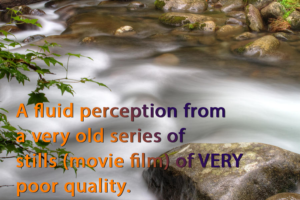 The concept of motion pictures can be dated even before the invention of silver imaging otherwise known as photography. In 1832, drawings were mounted on the face of a twirling disc called a phenakistoscope. Thus, mankind was treated to the illusion of motion.
The concept of motion pictures can be dated even before the invention of silver imaging otherwise known as photography. In 1832, drawings were mounted on the face of a twirling disc called a phenakistoscope. Thus, mankind was treated to the illusion of motion.
When we compare the illusion of the nineteenth century phenakistoscope to the illusion of motion today of Hollywood’s blockbusters, we can conclude that much progress has been made in making the illusion of motion realistic and fluid.
But now consider something in between. Consider the twenty-first century duplication to digital of early twentieth century home movies. Hollywood and otherwise professional movies were captured at 24 frames-per-second (fps) while consumer home movies were typically captured at 18 fps.
It is intuitive to recognize that if there is less time between still frames that the illusion of motion will become more fluid and therefore more pleasing to view. When Hollywood blockbuster films are duplicated to digital, each frame is scanned at typically 3,000 dpi by a very expensive machine designed explicitly for duplicating 35mm Hollywood movie film to digital providing stunning resolution. Then, in order to match the frame-rate of the National Television System Committe (NTSC) standard (30 fps), a frame is duplicated periodically so as to match the NTSC standard. This process is very, very expensive. Hollywood films have commercial value and therefore are worthy of funding for the expensive duplication. Advertisers will pay to have their messages attached to these films creating a clear funding path for the expensive duplication.
Home movie film only has personal value. The typical consumer is not able to fund a hundred thousand dollars for home movie film duplication. This has created an entire industry devoted to legacy media duplication to digital. W. Cardone Productions is proud to say with boldness that we are among the very BEST for consumer duplications on a planetary scale.
There are a couple of technological approaches used within the consumer duplication industry. One popular one is called frame-by-frame capture. This method in many ways duplicates the Hollywood process outlined above. The major difference, however, between these two is the manner in which each frame is captured. Hollywood does a 3,000 dpi scan of each frame as noted earlier. In the consumer duplication market, a video camcorder 1080p frame is captured for each movie film frame–one-to-one capture. While the resolution may be half, the more important consideration is the limitation of video to dot scanning. Even if the resolution were the same, the quality difference would still be an order of magnitude difference.
Consider also the time to capture one reel of film. A frame-by-frame capture proceeds at about 0.75 seconds per frame. A typical 50 foot reel of film (at 18 fps) will have
But let us not forget that a pull-down must still be executed to get 18 fps to look like 30 fps. That means that for every second of playing time, 12 duplicate frames must be added. The operative word here is “duplicate.” Intuitively, this means a longer time per frame and therefore intuitively, less fluid motion.
What does all this mean? It means a lot of labor and therefore a lot of cost. The machines that do this cost a lot of money as well. It is hard as heck to be profitable.
At W. Cardone Productions we face the same issue to a degree since we get the same film originally captured at 18 fps. Like the frame-by-frame services, we also have to figure out a way to show it at 30 fps. Our approach, however, is vastly different and MUCH more cost-effective while at the same time delivering the absolute finest quality available to the consumer.
One of the methods buried within our duplication workflow is a computer-controlled frame interpolation process. As the transcoder analyzes each frame, it also looks to each side at adjacent frames. Each frame is therefore transcoded for a very fluid appearance, as fluid as it can get.
Please view the sample video done from very old and very distressed movie film. We do not show this as an example of marvelous quality but rather, as a method to show what goes into fluid motion. There are three different algorithms available to us. For all around general use, one is slightly better than the other two. Please view the sample below and see if you come to the same conclusion. Although this clip is played in ultra-slow motion to help you see individual frame contribution to the overall movie, try to see the gravitational constant of the earth in action. This is just one more reason why we claim to be the very best in the consumer market.
